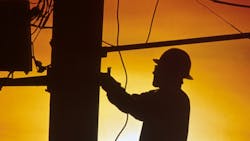In the last half of 2015, I had the opportunity to attend two conferences focusing on the future of the electric utility industry. While many of my fellow attendees found both of these conferences exciting, my reaction was more of concern. Having spent 38 years in the utility business, most of it as a lineman, my worries were different than most of the people in those hotel ballrooms. Quite simply: What role will a lineman play in the grid of the future?
At the New York Reforming the Energy Vision conference in August, I got some funny reactions when people saw IBEW 1245 on my badge. It was obvious many of the entrepreneurs looking to showcase their products seemed threatened by my union affiliation. I got a few dirty looks, but more common was the quizzical frown followed by, “Why are you here?” For those willing to have a conversation, my answer was simple, “We just want a seat at the table.”
I believe linemen can continue to provide value to utilities, and more importantly to customers, even if it means taking on new roles. This is not to say I don’t get a lot of skepticism from the linemen I now represent; many don’t perceive this threat to be real. It can be challenging to have a conversation with a group of linemen who have never had to worry about a lack of work or face a layoff. After all, there is a shortage of linemen nationally, with a slew of retirements coming in the next 10 years.
My fears are more long term, which can make for a tough dialog. This is more about preserving the trade for future generations. How many second- and third-generation linemen are in this country right now?
Let’s review what we can agree on. The utilities we grew up with are going away. For anyone to claim they know what a utility will look like in 10 years would be pure fantasy. Politics, rapidly changing technologies and the diverse needs of customers make that impossible. Nowhere is that more apparent than in California. While states like New York and Hawaii are leading the charge to define the future grid, California’s population, geography and weather make it the ultimate petri dish.
The first piece to figuring out where we are going seems to be the microgrid. Many states, or utilities, are in the initial step of “kicking the tires” with different technologies in various forms of a microgrid. A microgrid is a localized grid that can operate autonomously from the traditional grid. It may or may not be owned or operated by the local utility.
Regulators have the unenviable task of determining what role utilities, renewable resources, storage, fuel cells and customers will play in the future. Gov. Cuomo has created more than 80 microgrids throughout New York. Hawaii has what amounts to a large microgrid on each of its islands. Hawaii also plans to be 100% renewable power by 2045. Other states have aggressive goals to move toward distributed renewable energy systems. Wind, solar, fuel cells and storage are all components that will be part of the grid of the future. In New York, Superstorm Sandy was the catalyst for change, after customers went without power for up to two weeks. The new needs of customers and of the systems will shape the roles linemen will play.
Given all that we do know, I return to my original premise: What role will a lineman play in the grid of the future? It would be misleading to say there will never be another wire down or a pole knocked down by a driver on a cellphone.
The need for traditional linemen will exist for a long time. But, in my opinion, it would be foolish not to look at all of the opportunities in the grid of the future. Naysayers will question my motives. Sure, the union guy in California has a vested interest in keeping his membership at a high number. To that I answer, isn’t a flexible workforce every bit as valuable as the flexibility a microgrid offers?
Linemen are accustomed to working in any condition at any time of day. With training, who better to call if there are issues with a battery or fuel cell, whether it be 2 a.m. or 2 p.m.? Certainly, there would need to be growth in skills and training, but if these new technologies are to exist within the distribution grid, why not leverage the people who already have many of the requisite skills?
There are many hurdles to get over before we can be certain of what the future utility will look like. Regulators and lawyers will work that out. However, to sit on the sidelines and assume it will be business as usual would be myopic. Workers need to understand that we need to anticipate the new requirements, grow and continue to look for ways to bring value to employers.
The 32nd Annual International Lineman’s Rodeo took place in October. The traditional events have not changed much over the years. Who’s to say that 25 years down the road there won’t be a competition to replace battery storage?
To summarize, much of this could be years down the road. There is a plethora of issues that need to be sorted out. Many of those vary by state or utility. My hope is only that lineman always have a place in the game. You may be pleasantly surprised at the returns we provide.
Bob Gerstle has been with Pacific Gas and Electric Co. for 38 years and has worked as a lineman for 32 years. The last three years, Gerstle has represented linemen with IBEW 1245.
